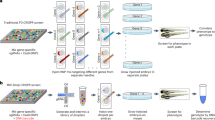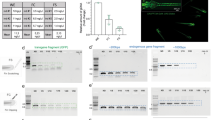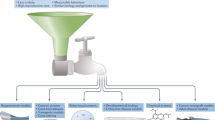Abstract
Chemical genetic screening can be described as a discovery approach in which chemicals are assayed for their effects on a defined biological system. The zebrafish, Danio rerio, is a well-characterized and genetically tractable vertebrate model organism that produces large numbers of rapidly developing embryos that develop externally. These characteristics allow for flexible, rapid and scalable chemical screen design using the zebrafish. We describe a protocol for screening compounds from a chemical library for effects on early zebrafish development using an automated in situ based read-out. As screenings are carried out in the context of a complete, developing organism, this approach allows for a more comprehensive analysis of the range of a chemical's effects than that provided by, for example, a cell culture-based or in vitro biochemical assay. Using a 24-h chemical treatment, one can complete a round of screening in 6 d.
This is a preview of subscription content, access via your institution
Access options
Subscribe to this journal
Receive 12 print issues and online access
$259.00 per year
only $21.58 per issue
Buy this article
- Purchase on Springer Link
- Instant access to full article PDF
Prices may be subject to local taxes which are calculated during checkout



Similar content being viewed by others
References
Frese, K.K. & Tuveson, D.A. Maximizing mouse cancer models. Nat. Rev. Cancer 7, 645–658 (2007).
Elliott, D.A. & Brand, A.H. The GAL4 system: a versatile system for the expression of genes. Methods Mol. Biol. 420, 79–95 (2008).
Martin, B.L. & Kimelman, D. Regulation of canonical Wnt signaling by Brachyury is essential for posterior mesoderm formation. Dev. Cell 15, 121–133 (2008).
Chen, C.M. & Struhl, G. Wingless transduction by the Frizzled and Frizzled2 proteins of Drosophila. Development 126, 5441–5452 (1999).
Chen, J.K., Taipale, J., Young, K.E., Maiti, T. & Beachy, P.A. Small molecule modulation of Smoothened activity. Proc. Natl. Acad. Sci. USA 99, 14071–14076 (2002).
Frank-Kamenetsky, M . et al. Small-molecule modulators of Hedgehog signaling: identification and characterization of Smoothened agonists and antagonists. J. Biol. 1, 10 (2002).
Jiang, X. et al. Distinctive roles of PHAP proteins and prothymosin-alpha in a death regulatory pathway. Science 299, 223–226 (2003).
Rosania, G.R. et al. Myoseverin, a microtubule-binding molecule with novel cellular effects. Nat. Biotechnol. 18, 304–308 (2000).
Wu, X., Ding, S., Ding, Q., Gray, N.S. & Schultz, P.G. A small molecule with osteogenesis-inducing activity in multipotent mesenchymal progenitor cells. J. Am. Chem. Soc. 124, 14520–14521 (2002).
Druker, B.J. & Lydon, N.B. Lessons learned from the development of an abl tyrosine kinase inhibitor for chronic myelogenous leukemia. J. Clin. Invest. 105, 3–7 (2000).
Lokey, R.S. Forward chemical genetics: progress and obstacles on the path to a new pharmacopoeia. Curr. Opin. Chem. Biol. 7, 91–96 (2003).
Stern, H.M. et al. Small molecules that delay S phase suppress a zebrafish bmyb mutant. Nat. Chem. Biol. 1, 366–70 (2005).
Murphey, R.D., Stern, H.M., Straub, C.T. & Zon, L.I. A chemical genetic screen for cell cycle inhibitors in zebrafish embryos. Chem. Biol. Drug Des. 68, 213–219 (2006).
North, T.E. et al. Prostaglandin E2 regulates vertebrate haematopoietic stem cell homeostasis. Nature 447, 1007–1011 (2007).
Lieschke, G.J. & Currie, P.D. Animal models of human disease: zebrafish swim into view. Nat. Rev. Genet. 8, 353–367 (2007).
Peterson, R.T., Link, B.A., Dowling, J.E. & Schreiber, S.L. Small molecule developmental screens reveal the logic and timing of vertebrate development. Proc. Natl. Acad. Sci. USA 97, 12965–12969 (2000).
Yang, C. & Johnson, S.L. Small molecule-induced ablation and subsequent regeneration of larval zebrafish melanocytes. Development 133, 3563–3573 (2006).
Yang, C., Hindes, A.E., Hultman, K.A. & Johnson, S.L. Mutations in gfpt1 and skiv2l2 cause distinct stage-specific defects in larval melanocyte regeneration in zebrafish. PLoS Genet. 3, e88 (2007).
Peterson, R.T. et al. Chemical suppression of a genetic mutation in a zebrafish model of aortic coarctation. Nat. Biotechnol. 22, 595–599 (2004).
Goessling, W. et al. Genetic interaction of PGE2 and Wnt signaling regulates developmental specification of stem cells and regeneration. Cell 136, 1136–1147 (2009).
Yeh, J.J. et al. Discovering chemical modifiers of oncogene-regulated hematopoietic differentiation. Nat. Chem. Biol. 5, 236–243 (2009).
Kimmel, C.B., Ballard, W.W., Kimmel, S.R., Ullmann, B. & Schilling, T.F. Stages of embryonic development of the zebrafish. Dev. Dyn. 203, 253–310 (1995).
Mayer, T.U. Chemical genetics: tailoring tools for cell biology. Trends Cell Biol. 13, 270–277 (2003).
Thisse, C. & Thisse, B. High-resolution in situ hybridization to whole-mount zebrafish embryos. Nat. Protoc. 3, 59–69 (2008).
Engel, T. Basic overview of chemoinformatics. J. Chem. Inf. Model 46, 2267–2277 (2006).
Vogt, A. et al. Automated image-based phenotypic analysis in zebrafish embryos. Dev. Dyn. 238, 656–663 (2009).
Molina, G.A., Watkins, S.C. & Tsang, M. Generation of FGF reporter transgenic zebrafish and their utility in chemical screens. BMC Dev. Biol. 7, 62 (2007).
Yu, P.B. et al. Dorsomorphin inhibits BMP signals required for embryogenesis and iron metabolism. Nat. Chem. Biol. 4, 33–41 (2008).
Owens, K.N. et al. Identification of genetic and chemical modulators of zebrafish mechanosensory hair cell death. PLoS Genet. 4, e1000020 (2008).
Acknowledgements
The authors would like to thank T. North and W. Goessling for use of runx1/cmyb in situ figures. We thank S. Datta and P. Manos for informative discussions. Thanks to C. Mosimann and J. Dejong for critical reading of the manuscript. C.K.K. is supported by NIH grant 5T32CA09172-34. R.M.W. is supported by NIH grant 1K08AR055368.
Author information
Authors and Affiliations
Contributions
C.K.K. and R.M.W. contributed equally to this work and worked under the guidance and direction of L.Z.
Corresponding author
Rights and permissions
About this article
Cite this article
Kaufman, C., White, R. & Zon, L. Chemical genetic screening in the zebrafish embryo. Nat Protoc 4, 1422–1432 (2009). https://doi.org/10.1038/nprot.2009.144
Published:
Issue Date:
DOI: https://doi.org/10.1038/nprot.2009.144
This article is cited by
-
A novel DSP zebrafish model reveals training- and drug-induced modulation of arrhythmogenic cardiomyopathy phenotypes
Cell Death Discovery (2023)
-
Endosulfan affects embryonic development synergistically under elevated ambient temperature
Environmental Science and Pollution Research (2023)
-
Tools of the trade: studying actin in zebrafish
Histochemistry and Cell Biology (2020)
-
Standardized mounting method of (zebrafish) embryos using a 3D-printed stamp for high-content, semi-automated confocal imaging
BMC Biotechnology (2019)
-
Improving zebrafish embryo xenotransplantation conditions by increasing incubation temperature and establishing a proliferation index with ZFtool
BMC Cancer (2018)
Comments
By submitting a comment you agree to abide by our Terms and Community Guidelines. If you find something abusive or that does not comply with our terms or guidelines please flag it as inappropriate.



